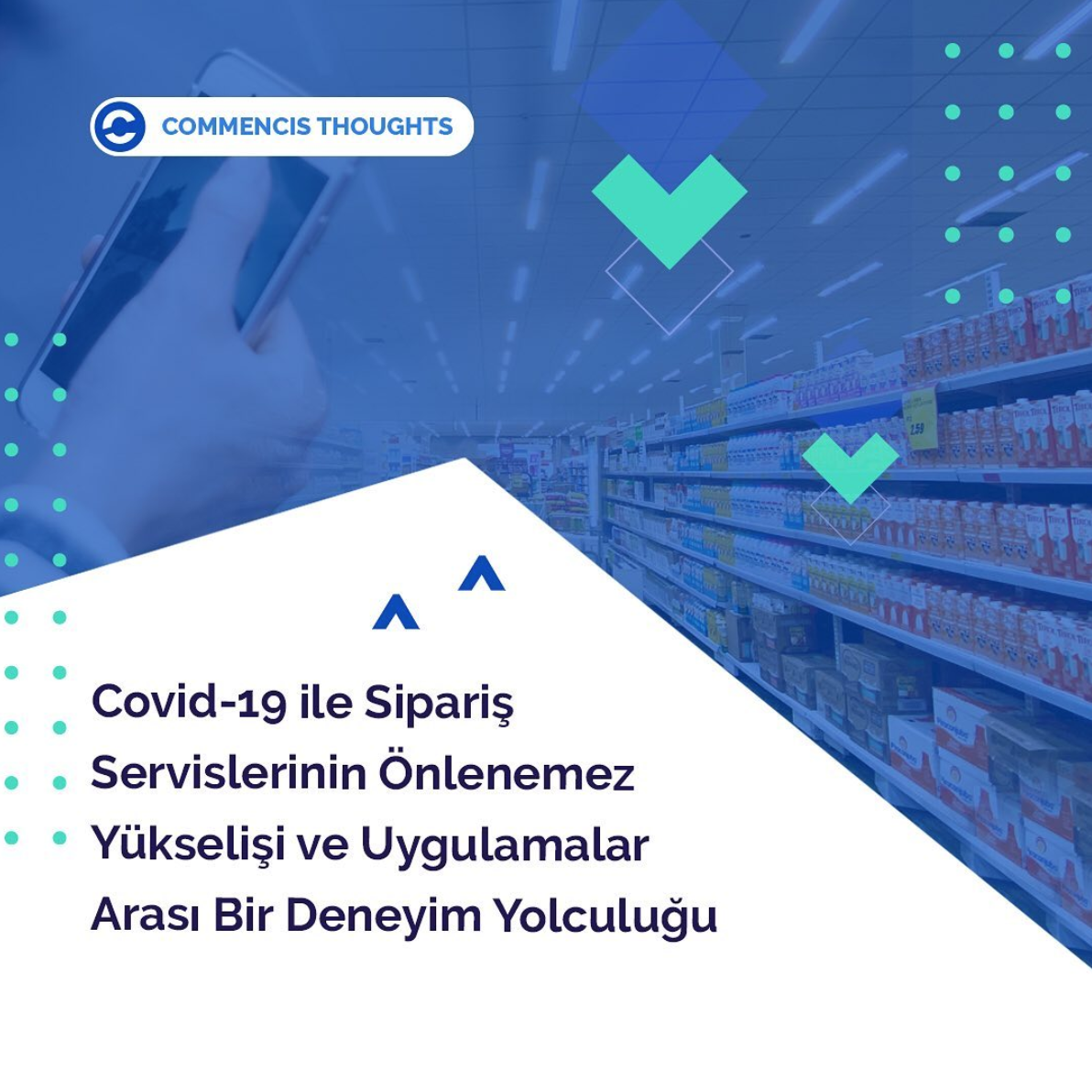How digital redefines the “normal” inpost COVID-19 world
How digital redefines the “normal” inpost COVID-19 world
27/05/2020
Reading Time: 21 minutes
While the unprecedented impact of COVID-19 on the global economy as well as our daily lives is still very much current, the discussions about reopening the economy and getting back to normal have been expedited. Getting back to the “normal”, if we ever can, will undoubtedly be a long and uncertain period in which we will see profound changes in our experiences and journeys.
We imagine the “new normal” for our daily interactions through the lens of digital transformation, and how digital solutions can help us to overcome the challenges we face and make the world a safer place.
RETAIL >
The series of strict measures to fight the coronavirus outbreak has impacted different retail sub-sectors in a different way. While consumer focus has shifted to essential items like food and medical supplies, apparel stores have experienced a major drop in revenue during the first weeks of the crisis being largely shut down.
Besides the change in consumer preferences, many people have looked for new ways to shop their needs and they have been basically been forced to start using digital channels. A rapid shift in consumer shopping behavior and uptick in online shopping are forcing retailers to invest more in digital solutions.
On-demand Grocery Delivery Apps
With shoppers locked down looking for alternatives to brick and mortar grocery storey, many customers have downloaded online grocery apps and tried new services. According to research by consulting firm Bain & Company, the share of online grocery has surged to 10% to 15% of total grocery spend in the U.S. which is staggering compared to 3% or 4% online grocery spending before the pandemic. 42% of consumers who bought groceries online or for pickup in the past few weeks had never done so before according to a research by Business Insider Intelligence.
To meet increasing demand for online grocery shopping, players such as Instacart have hired thousands of new workers during the crisis and continue to hire more. Some players like Amazon announced that they will not accept any new customers.
While online retailers are struggling to meet the consumer demand, this rapid shift in consumer shopping behavior seems to stay. 52% of consumers say that they will stick to their new digital grocery shopping methods after the crisis ends. Research by McKinsey & Company also predicts that online grocery will level off at 5% or 6%.
Direct-to-Consumer (D2C) Platforms
Direct-to-Consumer (D2C) model has been a subject of long-standing debate for the Consumer Packaged Goods (CPG) industry. For CPG manufacturers which heavily relies on brick-and-mortar retailers, online channels have not been prioritized by CPG players but few who have invested into fast-growing companies like Dollar Shave Club in recent years.
With the coronavirus limiting the number of consumers strolling down the aisles of supermarkets and relying on online channels for their grocery supplies, CPG manufacturers are to consider digital initiatives and open their own platforms not only to control the sales activities but also deliver more value to consumers with the enhanced brand experience. D2C platforms enable manufacturers to control pricing and tailor the brand experience by collecting consumer data and personalizing the experience.
Click-and-Collect Models
As coronavirus restrictions ease and consumers are gradually shifting back to more normalized shopping patterns, we will see retailers investing in click-and-collect models like Amazon lockers providing their customers an option to order ahead and pick up at the store. Consumers will be more likely to adapt these models not only because of its convenience, but also safety reasons.
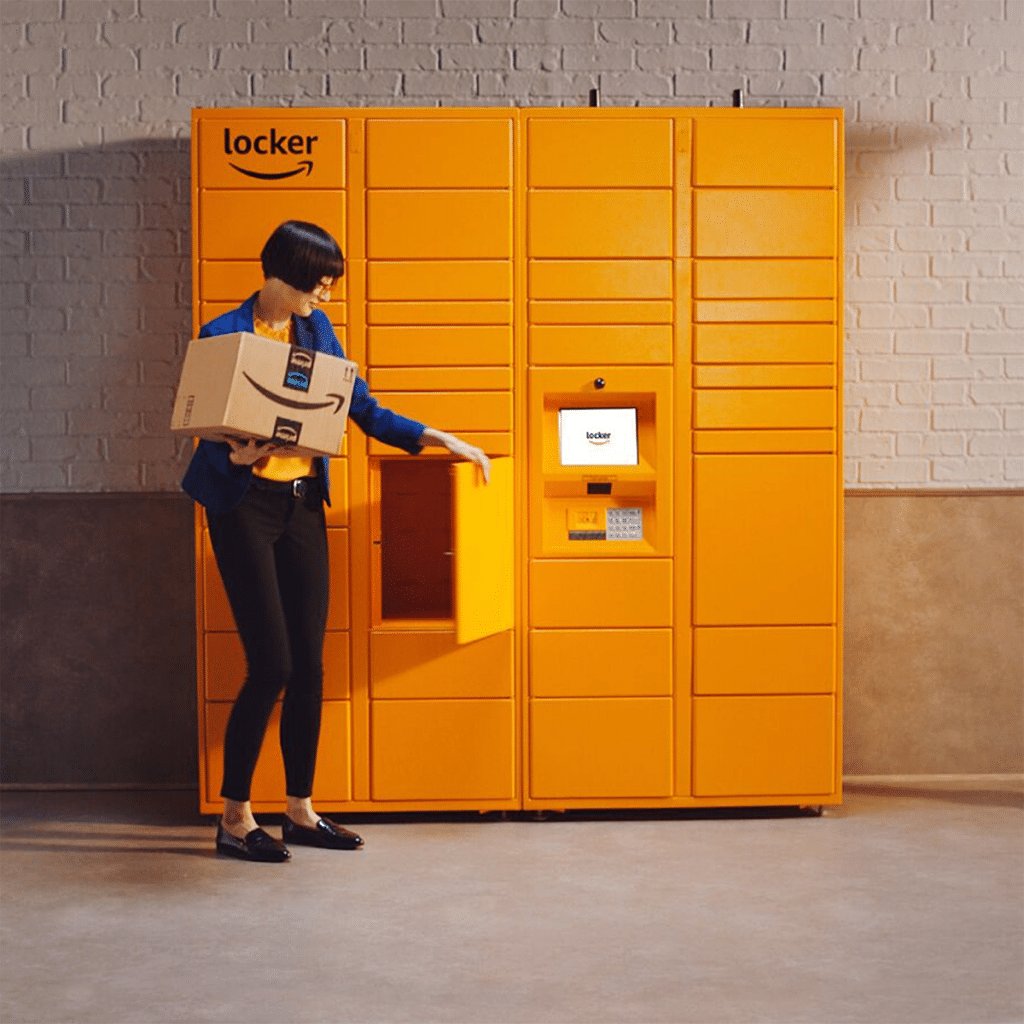
Dark Stores
With the retailers investing in digital channels and click-and-collect models, stores will shift to being fulfillment centers and employee-only dark stores which are considered as the future model of grocery. Recently, Whole Foods has converted stores in Los Angeles and New York to dark stores to meet with online demand. Other grocery chains and players are also testing dark stores and micro-fulfillment centers.
While supermarkets are trying to meet with consumer expectations and overcome logistical challenges of delivery, rapid fulfillment of customer orders is critical for customer loyalty. Supported by digital platforms, the pickers, employees who are responsible for order fulfillment, can easily locate the ordered product within these dark stores by using the quickest route through the store calculated by the system.
New Online Channels
According to McKinsey&Company, small and medium-size businesses account for approximately 48 percent of the US economy and provide employment to about 60 million people in the US. Today, more than 48 million small business jobs are at risk from a collapse, and according to Yelp, 176 thousand businesses marked closed on Yelp by April 19th.
As small businesses will likely to remain closed or impacted by lower consumer demand, many will need to find new ways to transform their businesses and operations. With companies like Facebook and Shopify, small businesses can offer their products through these new channels.
As of May 19th, Facebook and Instagram have announced that they will extend their support for e-commerce and introduce Facebook Shop for free for businesses. With nearly 1 million businesses already signed up for a global test of the feature, Facebook Shop enables businesses to upload their catalog, choose the products they want to feature, customize it with a cover image and accent colors. Visitors can browse, save and order products. Partnered with third-party platforms such as Shopify, BigCommerce, Woo, merchants can get control over customization and merchandising for their storefronts as well.
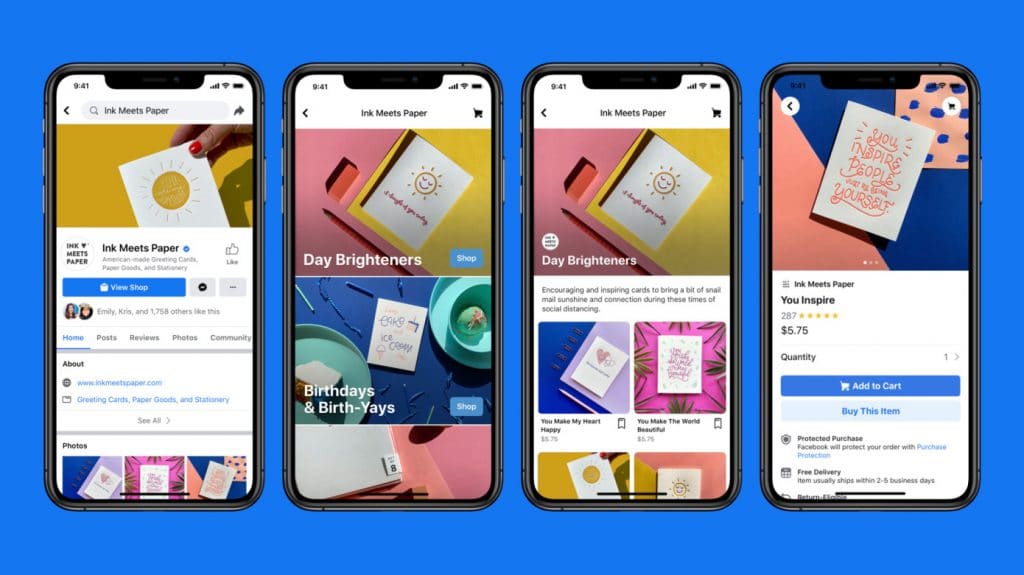
Another innovation was introduced by Shopify in April by introducing a consumer shopping app, called Shop. Shop app allows users in North America to browse and purchase products from the local merchants that use Shopify’s e-commerce platform and support them during the crisis.

New Consumer Needs, New Digital Solutions
As consumers are shifting to online channels, startups like Squadded Shopping Party will more likely emerge to meet with new consumer needs. This new app allows its users to simply open one of the online fashion stores listed, invite their friends to join their squad and shop together virtually. Users can interact with each other, give their advice by creating a poll or share their favourite looks and create outfits.
Also, department store chains like Kohl’s accelerated their use of digital solutions by teaming up with Snapchat on an augmented reality virtual closet. Leveraging Snapchat’s AR Portal technology, Kohl’s enables its users to virtually browse a selection of its athleisure products from home.
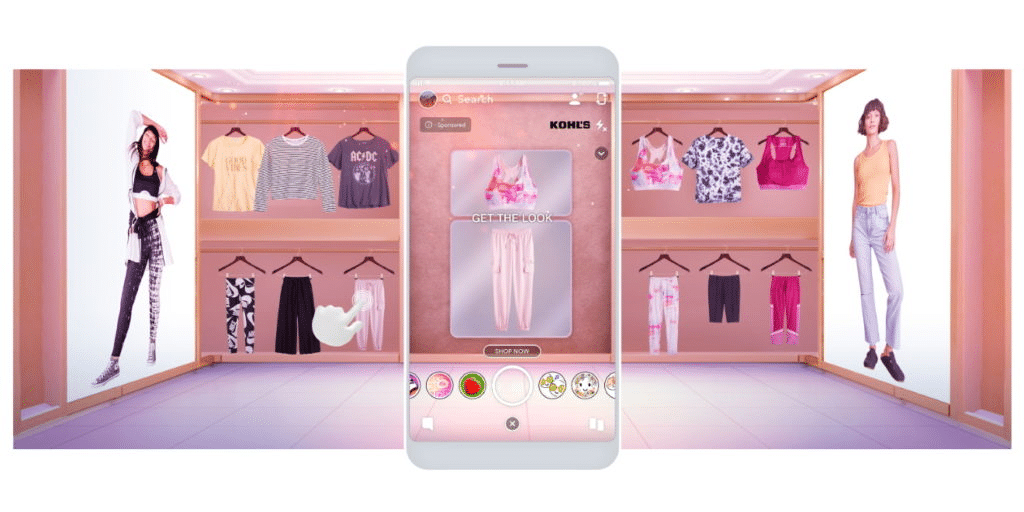
Scalable Platforms
With more consumers shifting to online channels, retailers need to invest more on scalability of their online platforms to support increases in traffic. Digital product owners and IT teams should consider undertaking initiatives on cloud and product engineering to ensure scalability of digital channels.
27/05/2020
Reading Time: 21 minutes
While the unprecedented impact of COVID-19 on the global economy as well as our daily lives is still very much current, the discussions about reopening the economy and getting back to normal have been expedited. Getting back to the “normal”, if we ever can, will undoubtedly be a long and uncertain period in which we will see profound changes in our experiences and journeys.
We imagine the “new normal” for our daily interactions through the lens of digital transformation, and how digital solutions can help us to overcome the challenges we face and make the world a safer place.
RETAIL >
The series of strict measures to fight the coronavirus outbreak has impacted different retail sub-sectors in a different way. While consumer focus has shifted to essential items like food and medical supplies, apparel stores have experienced a major drop in revenue during the first weeks of the crisis being largely shut down.
Besides the change in consumer preferences, many people have looked for new ways to shop their needs and they have been basically been forced to start using digital channels. A rapid shift in consumer shopping behavior and uptick in online shopping are forcing retailers to invest more in digital solutions.
On-demand Grocery Delivery Apps
With shoppers locked down looking for alternatives to brick and mortar grocery storey, many customers have downloaded online grocery apps and tried new services. According to research by consulting firm Bain & Company, the share of online grocery has surged to 10% to 15% of total grocery spend in the U.S. which is staggering compared to 3% or 4% online grocery spending before the pandemic. 42% of consumers who bought groceries online or for pickup in the past few weeks had never done so before according to a research by Business Insider Intelligence.
To meet increasing demand for online grocery shopping, players such as Instacart have hired thousands of new workers during the crisis and continue to hire more. Some players like Amazon announced that they will not accept any new customers.
While online retailers are struggling to meet the consumer demand, this rapid shift in consumer shopping behavior seems to stay. 52% of consumers say that they will stick to their new digital grocery shopping methods after the crisis ends. Research by McKinsey & Company also predicts that online grocery will level off at 5% or 6%.
Direct-to-Consumer (D2C) Platforms
Direct-to-Consumer (D2C) model has been a subject of long-standing debate for the Consumer Packaged Goods (CPG) industry. For CPG manufacturers which heavily relies on brick-and-mortar retailers, online channels have not been prioritized by CPG players but few who have invested into fast-growing companies like Dollar Shave Club in recent years.
With the coronavirus limiting the number of consumers strolling down the aisles of supermarkets and relying on online channels for their grocery supplies, CPG manufacturers are to consider digital initiatives and open their own platforms not only to control the sales activities but also deliver more value to consumers with the enhanced brand experience. D2C platforms enable manufacturers to control pricing and tailor the brand experience by collecting consumer data and personalizing the experience.
Click-and-Collect Models
As coronavirus restrictions ease and consumers are gradually shifting back to more normalized shopping patterns, we will see retailers investing in click-and-collect models like Amazon lockers providing their customers an option to order ahead and pick up at the store. Consumers will be more likely to adapt these models not only because of its convenience, but also safety reasons.

Dark Stores
With the retailers investing in digital channels and click-and-collect models, stores will shift to being fulfillment centers and employee-only dark stores which are considered as the future model of grocery. Recently, Whole Foods has converted stores in Los Angeles and New York to dark stores to meet with online demand. Other grocery chains and players are also testing dark stores and micro-fulfillment centers.
While supermarkets are trying to meet with consumer expectations and overcome logistical challenges of delivery, rapid fulfillment of customer orders is critical for customer loyalty. Supported by digital platforms, the pickers, employees who are responsible for order fulfillment, can easily locate the ordered product within these dark stores by using the quickest route through the store calculated by the system.
New Online Channels
According to McKinsey&Company, small and medium-size businesses account for approximately 48 percent of the US economy and provide employment to about 60 million people in the US. Today, more than 48 million small business jobs are at risk from a collapse, and according to Yelp, 176 thousand businesses marked closed on Yelp by April 19th.
As small businesses will likely to remain closed or impacted by lower consumer demand, many will need to find new ways to transform their businesses and operations. With companies like Facebook and Shopify, small businesses can offer their products through these new channels.
As of May 19th, Facebook and Instagram have announced that they will extend their support for e-commerce and introduce Facebook Shop for free for businesses. With nearly 1 million businesses already signed up for a global test of the feature, Facebook Shop enables businesses to upload their catalog, choose the products they want to feature, customize it with a cover image and accent colors. Visitors can browse, save and order products. Partnered with third-party platforms such as Shopify, BigCommerce, Woo, merchants can get control over customization and merchandising for their storefronts as well.

Another innovation was introduced by Shopify in April by introducing a consumer shopping app, called Shop. Shop app allows users in North America to browse and purchase products from the local merchants that use Shopify’s e-commerce platform and support them during the crisis.

New Consumer Needs, New Digital Solutions
As consumers are shifting to online channels, startups like Squadded Shopping Party will more likely emerge to meet with new consumer needs. This new app allows its users to simply open one of the online fashion stores listed, invite their friends to join their squad and shop together virtually. Users can interact with each other, give their advice by creating a poll or share their favourite looks and create outfits.
Also, department store chains like Kohl’s accelerated their use of digital solutions by teaming up with Snapchat on an augmented reality virtual closet. Leveraging Snapchat’s AR Portal technology, Kohl’s enables its users to virtually browse a selection of its athleisure products from home.

Scalable Platforms
With more consumers shifting to online channels, retailers need to invest more on scalability of their online platforms to support increases in traffic. Digital product owners and IT teams should consider undertaking initiatives on cloud and product engineering to ensure scalability of digital channels.
TRAVEL >
Today, more than 90 percent of the world’s population, or 7.1 billion people, lives in countries with travel restrictions causing global airlines a potential loss of USD 252 billion passenger revenue in 2020, which would be 44 percent lower than 2019 figures. While many governments have been discussing reopening the economy and restarting international flights, we will see significant changes in our travel experience.
Touchless Travel
The most immediate change we will observe will be a shift to contactless transactions throughout the travel journey. From airline check-in to boarding, contactless solutions will become the new norm. In our new flight experience, we will be using technologies such as facial recognition, iris scan, contactless document scanning, gesture control to fill out the forms, identify ourselves during passport control and boarding a flight to reduce the risk of contamination.
The shift to contactless services will also uptick in hotels with the help of new technological solutions. New QR-code based digital solutions will enable hotel visitors to order digitally, pay for their visit, order room service or book a cab or spa appointment.
Medical Monitoring
Airlines and airports will adopt technologies for medical monitoring and scanning to identify passengers who have a potential risk of COVID-19 infection. Although these thermal scanners and tests are not designed for diagnosis, they will play an important role to feel travelers safe. Etihad Airways has become an early mover to implement these contactless Covid-19 screening technologies.
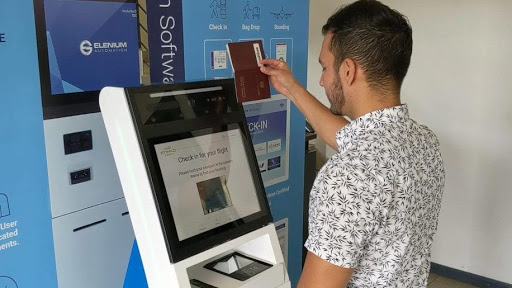
Traveller Identity
One of the early steps taken by international institutions to increase safety in air travel is the use of a common digital identity. One example is The World Economic Forum’s Known Traveller Digital Identity which brings together a global consortium of individuals, governments, authorities and the travel industry to facilitate safe and seamless journeys. The system enables consortium partners to access verifiable claims of a traveler’s identity data and travelers to manage their own profile, collect digital “attestations” of their identity data and decide which information to share. The initiatives such as IATA One ID will certainly accelerate and become a part of our travel experience to facilitate safe and seamless journeys
TRAVEL >
Today, more than 90 percent of the world’s population, or 7.1 billion people, lives in countries with travel restrictions causing global airlines a potential loss of USD 252 billion passenger revenue in 2020, which would be 44 percent lower than 2019 figures. While many governments have been discussing reopening the economy and restarting international flights, we will see significant changes in our travel experience.
Touchless Travel
The most immediate change we will observe will be a shift to contactless transactions throughout the travel journey. From airline check-in to boarding, contactless solutions will become the new norm. In our new flight experience, we will be using technologies such as facial recognition, iris scan, contactless document scanning, gesture control to fill out the forms, identify ourselves during passport control and boarding a flight to reduce the risk of contamination.
The shift to contactless services will also uptick in hotels with the help of new technological solutions. New QR-code based digital solutions will enable hotel visitors to order digitally, pay for their visit, order room service or book a cab or spa appointment.
Medical Monitoring
Airlines and airports will adopt technologies for medical monitoring and scanning to identify passengers who have a potential risk of COVID-19 infection. Although these thermal scanners and tests are not designed for diagnosis, they will play an important role to feel travelers safe. Etihad Airways has become an early mover to implement these contactless Covid-19 screening technologies.

Traveller Identity
One of the early steps taken by international institutions to increase safety in air travel is the use of a common digital identity. One example is The World Economic Forum’s Known Traveller Digital Identity which brings together a global consortium of individuals, governments, authorities and the travel industry to facilitate safe and seamless journeys. The system enables consortium partners to access verifiable claims of a traveler’s identity data and travelers to manage their own profile, collect digital “attestations” of their identity data and decide which information to share. The initiatives such as IATA One ID will certainly accelerate and become a part of our travel experience to facilitate safe and seamless journeys
PAYMENTS >
Contactless solutions are everywhere. The spread of coronavirus has significantly increased the importance of contactless solutions and payments using QR code, NFC or facial recognition to minimize the physical handoff that occurs with cash and credit cards. According to Mastercard, contactless payments jump 40% during the first quarter of 2020 as consumers are looking for quick ways to complete their shopping without exchanging cash or anything else.
The health and safety concerns due to coronavirus pandemic certainly accelerate the adaptation of new technologies. A recent study revealed that almost half (48%) of consumers are worried about handling cash at the moment and say they will be reducing the amount of cash they handle in the future while 63% of UK consumers say they will be using contactless payment technology more in the short term. As the popularity of digital wallets are increasing since the beginning of the pandemic, 12% of UK consumers have used them for the first time to make an online payment.
Facial Recognition
In China, which has the highest mobile payment adoption in the world, a new payment method using facial recognition technology was introduced last year. In the past 5 years, we saw that cash and cards have been replaced with mobile payment and QR code technology. Now, the leaders of biggest technology companies argue that new payment technologies such as facial recognition to replace QR codes.
Alipay has introduced its “Smile-to-Pay” system and is planning to spend $420m over three years on implementing the technology, while Tencent unveiled its “Frog Pro” system in August 2019. As both companies have point-of-sale (POS) technology offerings, they can easily accommodate facial recognition payments, and make it available and widely accepted accelerated with the spread of coronavirus.
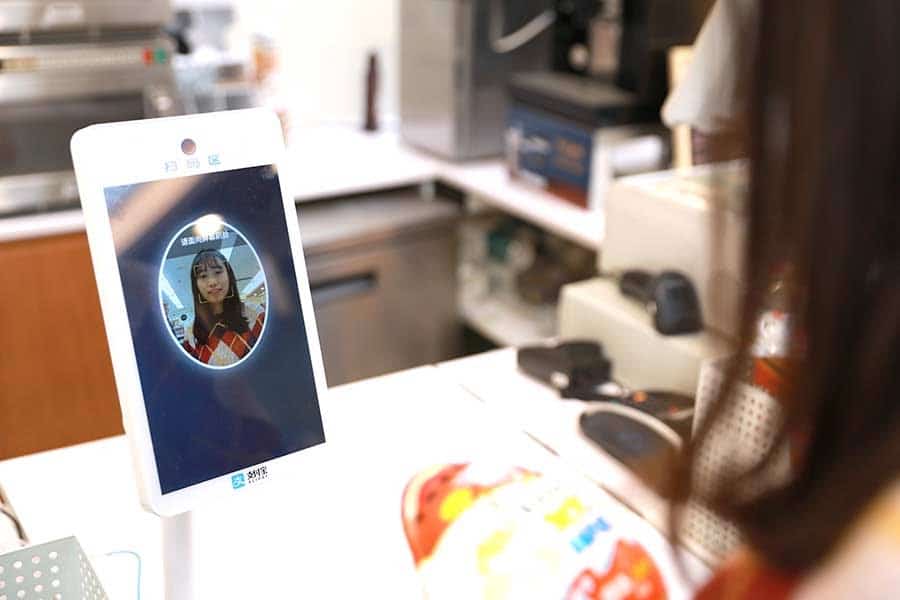
Although the facial recognition system raises privacy concerns and has experience issues that need to be addressed, we will see more technology providers introducing new payment technologies and testing the market.
PAYMENTS >
Contactless solutions are everywhere. The spread of coronavirus has significantly increased the importance of contactless solutions and payments using QR code, NFC or facial recognition to minimize the physical handoff that occurs with cash and credit cards. According to Mastercard, contactless payments jump 40% during the first quarter of 2020 as consumers are looking for quick ways to complete their shopping without exchanging cash or anything else.
The health and safety concerns due to coronavirus pandemic certainly accelerate the adaptation of new technologies. A recent study revealed that almost half (48%) of consumers are worried about handling cash at the moment and say they will be reducing the amount of cash they handle in the future while 63% of UK consumers say they will be using contactless payment technology more in the short term. As the popularity of digital wallets are increasing since the beginning of the pandemic, 12% of UK consumers have used them for the first time to make an online payment.
Facial Recognition
In China, which has the highest mobile payment adoption in the world, a new payment method using facial recognition technology was introduced last year. In the past 5 years, we saw that cash and cards have been replaced with mobile payment and QR code technology. Now, the leaders of biggest technology companies argue that new payment technologies such as facial recognition to replace QR codes.
Alipay has introduced its “Smile-to-Pay” system and is planning to spend $420m over three years on implementing the technology, while Tencent unveiled its “Frog Pro” system in August 2019. As both companies have point-of-sale (POS) technology offerings, they can easily accommodate facial recognition payments, and make it available and widely accepted accelerated with the spread of coronavirus.

Although the facial recognition system raises privacy concerns and has experience issues that need to be addressed, we will see more technology providers introducing new payment technologies and testing the market.
RESTAURANTS >
Restaurants, one of the most impacted industries from the pandemic, will probably require a very long time to return to normal even when they’re allowed to. In a post-COVID-19 world, consumers will continue to have safety concerns while they are dining in at a restaurant, which was once the place for connection, community and excitement. Research shows that the share of consumers dining at sit-down restaurants had declined 85.2% since the pandemic began, and 30% of consumers say that they will not go to restaurants like they once did.
Contactless Solutions
Consumers look for digital solutions and innovations that restaurants can introduce to limit contact and secure social distancing through the crisis. While restaurant operators started to invest for new solutions, 53% of consumers are downloading and using more apps like menu and ordering apps to reduce interaction and contact with on-site staff.
Gift Cards
While one of 5 restaurants are to close permanently in the US because of the pandemic, technology companies like Facebook, Toast, Square and Kabbage are introducing and promoting new ways to support small businesses such as gift cards. Restaurants which open an account in gift card providers or online delivery platforms can add a gift card option to their Instagram profile and share links directly from their stories for ordering and purchasing gift cards.
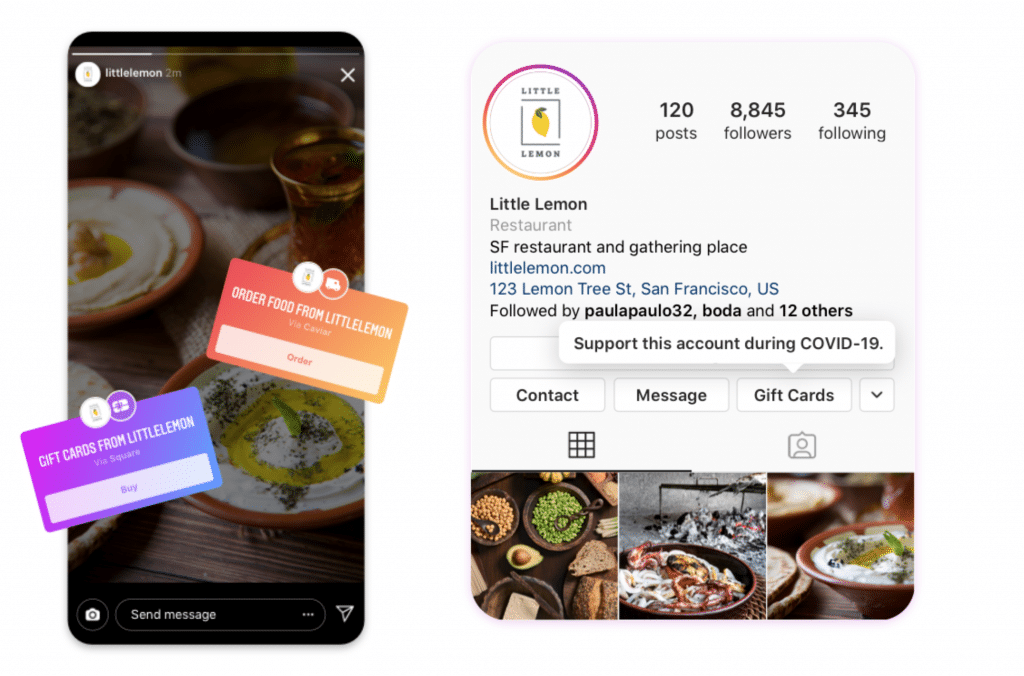
Delivery Apps and Ghost Kitchens
Delivery services, which have been negatively impacted by restaurants going to perilous hibernation and consumers with more time at home to cook for themselves, will likely recover with the ease of COVID-19 restrictions. While the idea that people are going to be spending money in restaurants being preposterous will stay for a while, we’ll see more restaurants which will turn into ghost kitchens offering delivery services, to-go boxes for loyal customers. Virtual or ghost kitchens such as C3, a subsidiary of SBE Entertainment Group, is already accelerating its growth by opening 138 ghost kitchens by the end of 2020 and hiring 1,000 employees to meet consumer demand which has doubled for food delivery.
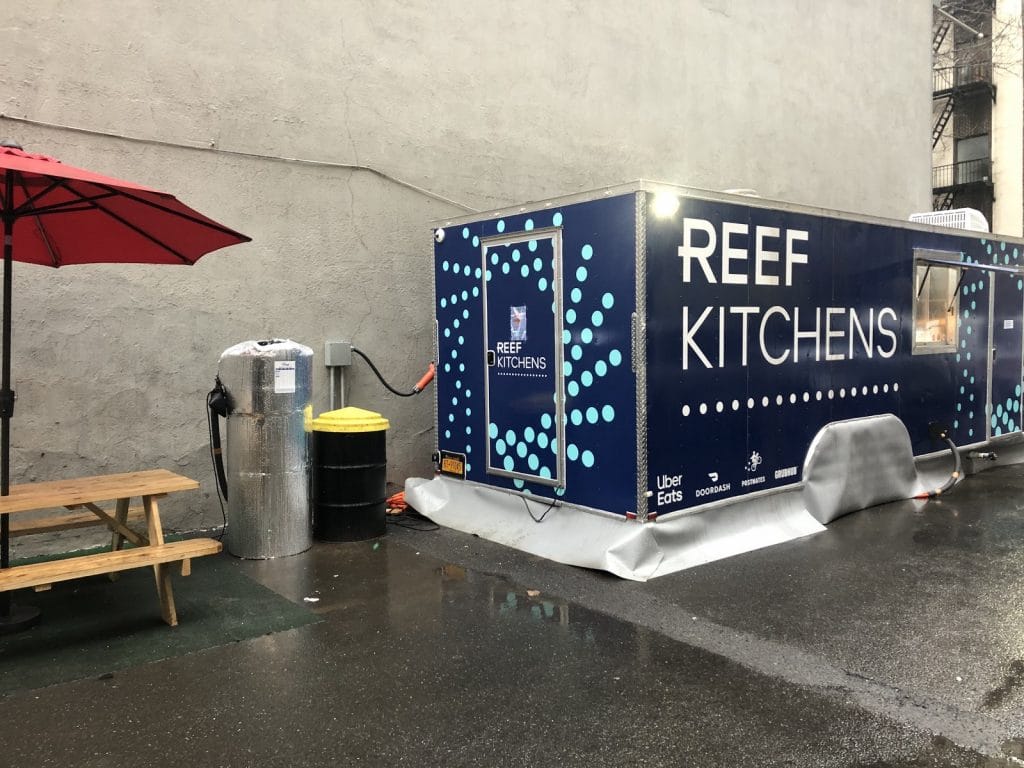
Online Delivery Platforms vs Building Your Own Delivery Solution
Today, food service is already becoming a whole new world in front of our eyes where delivery is a permanent part of the landscape, and restaurants will face questions about whether they want to work with food delivery aggregators like Uber Eats, GrubHub which are being criticized due to high commission fees or build out their own online ordering and delivery operations. In some countries like the UAE are launching their own food order delivery app to cut out the “middleman”. Undoubtedly, we’ll see more restaurants or countries investing into online ordering and delivery platforms.
RESTAURANTS >
Restaurants, one of the most impacted industries from the pandemic, will probably require a very long time to return to normal even when they’re allowed to. In a post-COVID-19 world, consumers will continue to have safety concerns while they are dining in at a restaurant, which was once the place for connection, community and excitement. Research shows that the share of consumers dining at sit-down restaurants had declined 85.2% since the pandemic began, and 30% of consumers say that they will not go to restaurants like they once did.
Contactless Solutions
Consumers look for digital solutions and innovations that restaurants can introduce to limit contact and secure social distancing through the crisis. While restaurant operators started to invest for new solutions, 53% of consumers are downloading and using more apps like menu and ordering apps to reduce interaction and contact with on-site staff.
Gift Cards
While one of 5 restaurants are to close permanently in the US because of the pandemic, technology companies like Facebook, Toast, Square and Kabbage are introducing and promoting new ways to support small businesses such as gift cards. Restaurants which open an account in gift card providers or online delivery platforms can add a gift card option to their Instagram profile and share links directly from their stories for ordering and purchasing gift cards.

Delivery Apps and Ghost Kitchens
Delivery services, which have been negatively impacted by restaurants going to perilous hibernation and consumers with more time at home to cook for themselves, will likely recover with the ease of COVID-19 restrictions. While the idea that people are going to be spending money in restaurants being preposterous will stay for a while, we’ll see more restaurants which will turn into ghost kitchens offering delivery services, to-go boxes for loyal customers. Virtual or ghost kitchens such as C3, a subsidiary of SBE Entertainment Group, is already accelerating its growth by opening 138 ghost kitchens by the end of 2020 and hiring 1,000 employees to meet consumer demand which has doubled for food delivery.

Online Delivery Platforms vs Building Your Own Delivery Solution
Today, food service is already becoming a whole new world in front of our eyes where delivery is a permanent part of the landscape, and restaurants will face questions about whether they want to work with food delivery aggregators like Uber Eats, GrubHub which are being criticized due to high commission fees or build out their own online ordering and delivery operations. In some countries like the UAE are launching their own food order delivery app to cut out the “middleman”. Undoubtedly, we’ll see more restaurants or countries investing into online ordering and delivery platforms.
HEALTH >
Although startups need to go through complex clinical and regulatory processes to enter the digital health market, it continues to attract investors and entrepreneurs to bring solutions to patients. Last year, more than 195,000 digital healthcare apps were launched and digital health startups raised over $17 billion across more than 1,700 deals in 2019.
A long list of innovative startups leverage digital technologies to introduce groundbreaking treatment methods and solutions – ranging from disease diagnostics to health insurance, to online surgical collaboration tools – and to fix the healthcare system which has been described as “broken”. With the spread of COVID-19, the challenges that the healthcare system faces have been accelerated, and bringing cost efficiency, quality and ease to access to care will be the top priorities for investors in new healthcare solutions.
Here are some of the categories in which we will see more digital health solutions in the following years:
Mental health apps help its users in terms of emotional, psychological and social well-being related problems. Talkspace, a telebehavioral healthcare company, enables its individual users to reach a network of licensed therapists through web and mobile platforms. Another example, Xmed provides useful features like the symptom detection, sick tracker and offer community based solutions.
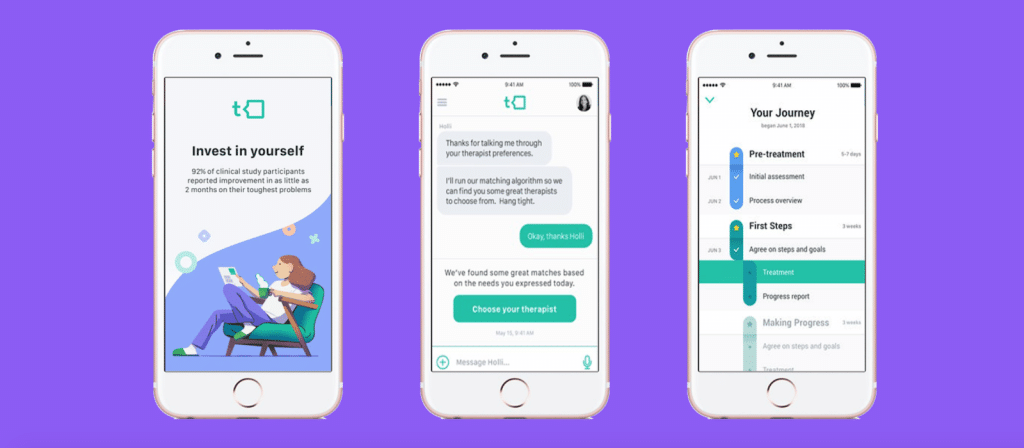
There are broader consumer platforms like Calm ($143M total funding) and Headspace ($169.4M) which focus more on consumer health & wellness and provide meditation, mindfulness activities and libraries alongside with the apps like Hims bringing a modern approach to health and wellness and making it easier for people to access care and treatment that impact their daily lives such as skin or hair problems.
Some platforms also enable users to track and share their vital health data. While Dreem, a sleep health company, focuses on tracking sleep activity, including brain activity, higi enables users to measure, track and act on their health data using self-screening in smart health stations.
Digital therapeutics companies like Akili are using software programs to prevent, manage and/or treat a medical disorder or disease. Glooko, a Silicon Valley digital therapeutics startup, enables clinicians to remotely access their patients’ blood glucose data and manage diabetes online.
Digital health solutions are, undoubtedly, making healthcare accessible for more people. Especially, telehealth companies aim to better leverage medical professionals’ time and enable them to remotely deliver clinical health services to patients. As people have safety concerns to visit hospitals, we’ll see more solutions such as Doctor on Demand, China-based We Doctor or One Medical Group ($402.5M total funding) combining human-centered design, technology and health professionals for 24/7 virtual care. By leveraging AI, platforms like Ada will help users to receive primary care and diagnostics without connecting with a physician.
Another fast-growing category, digital health insurance is also attracting consumers as well as investors by offering affordable individual and family plans, making it easy to process a claim and provide human-centered experience. Tech-focused health insurer Oscar is currently valued at $3.2B, while Bright Health is valued at $1B.
Besides consumer platforms, we’ll also see more solutions focusing on health providers, clinicians and physicians and enabling them with digital technologies. While solutions like Proximie enables surgeons to collaborate and remotely connect with their colleagues across the world, Heartflow makes it easy to diagnose coronary artery disease and Virasoft provides solutions for pathologists to collaborate and digitally diagnose.
HEALTH >
Although startups need to go through complex clinical and regulatory processes to enter the digital health market, it continues to attract investors and entrepreneurs to bring solutions to patients. Last year, more than 195,000 digital healthcare apps were launched and digital health startups raised over $17 billion across more than 1,700 deals in 2019.
A long list of innovative startups leverage digital technologies to introduce groundbreaking treatment methods and solutions – ranging from disease diagnostics to health insurance, to online surgical collaboration tools – and to fix the healthcare system which has been described as “broken”. With the spread of COVID-19, the challenges that the healthcare system faces have been accelerated, and bringing cost efficiency, quality and ease to access to care will be the top priorities for investors in new healthcare solutions.
Here are some of the categories in which we will see more digital health solutions in the following years:
Mental health apps help its users in terms of emotional, psychological and social well-being related problems. Talkspace, a telebehavioral healthcare company, enables its individual users to reach a network of licensed therapists through web and mobile platforms. Another example, Xmed provides useful features like the symptom detection, sick tracker and offer community based solutions.

There are broader consumer platforms like Calm ($143M total funding) and Headspace ($169.4M) which focus more on consumer health & wellness and provide meditation, mindfulness activities and libraries alongside with the apps like Hims bringing a modern approach to health and wellness and making it easier for people to access care and treatment that impact their daily lives such as skin or hair problems.
Some platforms also enable users to track and share their vital health data. While Dreem, a sleep health company, focuses on tracking sleep activity, including brain activity, higi enables users to measure, track and act on their health data using self-screening in smart health stations.
Digital therapeutics companies like Akili are using software programs to prevent, manage and/or treat a medical disorder or disease. Glooko, a Silicon Valley digital therapeutics startup, enables clinicians to remotely access their patients’ blood glucose data and manage diabetes online.
Digital health solutions are, undoubtedly, making healthcare accessible for more people. Especially, telehealth companies aim to better leverage medical professionals’ time and enable them to remotely deliver clinical health services to patients. As people have safety concerns to visit hospitals, we’ll see more solutions such as Doctor on Demand, China-based We Doctor or One Medical Group ($402.5M total funding) combining human-centered design, technology and health professionals for 24/7 virtual care. By leveraging AI, platforms like Ada will help users to receive primary care and diagnostics without connecting with a physician.
Another fast-growing category, digital health insurance is also attracting consumers as well as investors by offering affordable individual and family plans, making it easy to process a claim and provide human-centered experience. Tech-focused health insurer Oscar is currently valued at $3.2B, while Bright Health is valued at $1B.
Besides consumer platforms, we’ll also see more solutions focusing on health providers, clinicians and physicians and enabling them with digital technologies. While solutions like Proximie enables surgeons to collaborate and remotely connect with their colleagues across the world, Heartflow makes it easy to diagnose coronary artery disease and Virasoft provides solutions for pathologists to collaborate and digitally diagnose.
REMOTE WORKING >
While the measures taken for COVID-19 pandemic are encouraging everyone to stay indoors and practice social distancing, companies are forced to embrace remote working which has fueled the demand for online collaboration platforms. Today, even banks are shifting most of their employees to work from home.
Based on a recent survey conducted with HR managers, Gartner has revealed that only 30% of their employees worked remotely at least part of the time, while 81 percent or more are currently working remotely, and 41 percent are likely to do so at least some of the time once a return to normal working is permitted. No surprise, we’ll likely to see that some companies will allow their employees to work from home when restrictions ease with Twitter being one of the first companies to go to a work from home model in the face of novel coronavirus.
Online Communication & Video Conferencing
As tens of millions of employees started working from their kitchen or coffee tables, online tools like Slack make it possible to maintain workplace communication and collaboration. As demand for these tools skyrocketed worldwide during the past weeks, we’ve seen these platforms announcing a record number of new participants. Microsoft Teams has announced that the daily active users have passed 75 million while it has 44 million daily active users just six weeks ago. There is also a demand surge for other platforms such as Zoom, which has recently passed 300 million participants, and Google Meet passing 100 million daily participants.
Software Development
In the face of COVID-19, the companies are now forced to work remotely and increase efficiency in software development processes. More companies and IT teams are expected to implement DevOps and shift to Continuous Integration / Continuous Deployment which have been aspirational goals for many organizations for years. By using collaboration tools such as Zeplin, Figma, InVision for design, Git, Maven, Jenkins for development and TestRail, Appium for testing, organizations can better continually build digital platforms which can deliver value to their employees and customers.
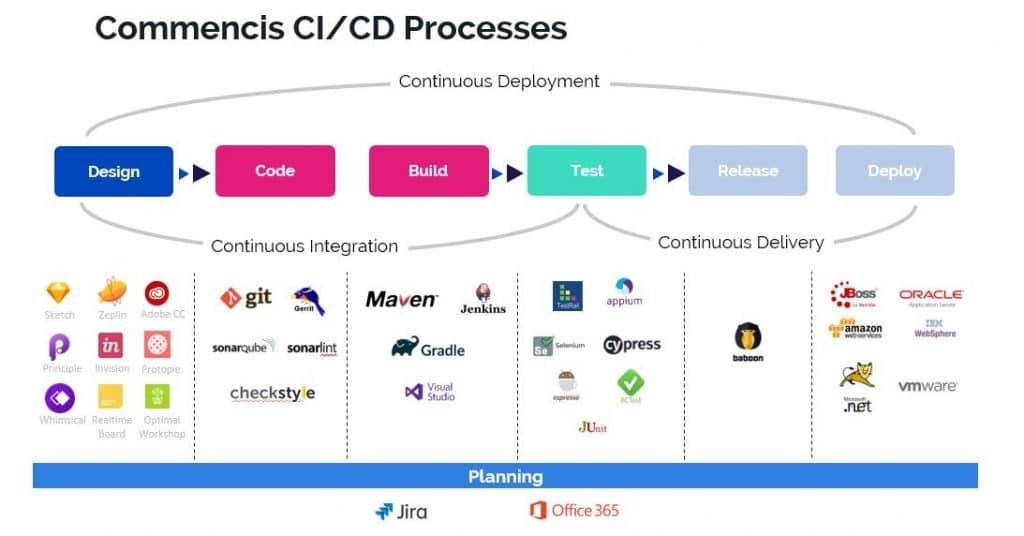
REMOTE WORKING >
While the measures taken for COVID-19 pandemic are encouraging everyone to stay indoors and practice social distancing, companies are forced to embrace remote working which has fueled the demand for online collaboration platforms. Today, even banks are shifting most of their employees to work from home.
Based on a recent survey conducted with HR managers, Gartner has revealed that only 30% of their employees worked remotely at least part of the time, while 81 percent or more are currently working remotely, and 41 percent are likely to do so at least some of the time once a return to normal working is permitted. No surprise, we’ll likely to see that some companies will allow their employees to work from home when restrictions ease with Twitter being one of the first companies to go to a work from home model in the face of novel coronavirus.
Online Communication & Video Conferencing
As tens of millions of employees started working from their kitchen or coffee tables, online tools like Slack make it possible to maintain workplace communication and collaboration. As demand for these tools skyrocketed worldwide during the past weeks, we’ve seen these platforms announcing a record number of new participants. Microsoft Teams has announced that the daily active users have passed 75 million while it has 44 million daily active users just six weeks ago. There is also a demand surge for other platforms such as Zoom, which has recently passed 300 million participants, and Google Meet passing 100 million daily participants.
Software Development
In the face of COVID-19, the companies are now forced to work remotely and increase efficiency in software development processes. More companies and IT teams are expected to implement DevOps and shift to Continuous Integration / Continuous Deployment which have been aspirational goals for many organizations for years. By using collaboration tools such as Zeplin, Figma, InVision for design, Git, Maven, Jenkins for development and TestRail, Appium for testing, organizations can better continually build digital platforms which can deliver value to their employees and customers.

Looking Ahead: Adapting to the “new normal” in Post-COVID-19 World
The path to “normal” will undoubtedly be a long one and companies will face further challenges to adapt to profoundly changed consumer preferences and habits. To better handle the disruption caused by the coronavirus crisis, companies should seize the opportunity to rapidly adopt digital transformation to become truly consumer-centric and build scalable platforms enabling experiences for long-lasting customer loyalty. Investing in digital technologies, customer experience and data management tools will certainly help companies to transform their business and turn the current crisis into an opportunity.
Don’t miss out the latestCommencis Thoughts and News.
Looking Ahead: Adapting to the “new normal” in Post-COVID-19 World
The path to “normal” will undoubtedly be a long one and companies will face further challenges to adapt to profoundly changed consumer preferences and habits. To better handle the disruption caused by the coronavirus crisis, companies should seize the opportunity to rapidly adopt digital transformation to become truly consumer-centric and build scalable platforms enabling experiences for long-lasting customer loyalty. Investing in digital technologies, customer experience and data management tools will certainly help companies to transform their business and turn the current crisis into an opportunity.


